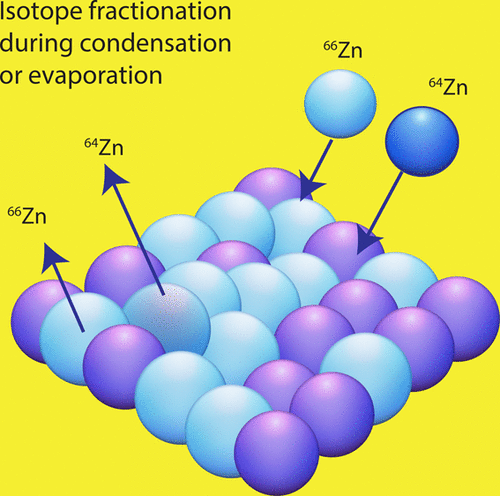当前位置:
X-MOL 学术
›
ACS Earth Space Chem.
›
论文详情
Our official English website, www.x-mol.net, welcomes your
feedback! (Note: you will need to create a separate account there.)
Isotope Fractionation during Condensation and Evaporation during Planet Formation Processes
ACS Earth and Space Chemistry ( IF 2.9 ) Pub Date : 2020-07-10 , DOI: 10.1021/acsearthspacechem.0c00139 Bernard Bourdon 1 , Caroline Fitoussi 1
ACS Earth and Space Chemistry ( IF 2.9 ) Pub Date : 2020-07-10 , DOI: 10.1021/acsearthspacechem.0c00139 Bernard Bourdon 1 , Caroline Fitoussi 1
Affiliation

|
During the early stages of a protoplanetary disk, it is expected that the temperatures reached in the disk will lead to total or partial vaporization of dust, followed by condensation upon cooling. Similarly, chondrule forming events or giant impacts followed by magma oceans can also produce partial evaporation. Thus, moderately volatile elements can be mobilized during these thermal events, thereby leading to characteristic isotope signatures that can be used to decipher the conditions of elemental fractionation. Indeed, the magnitude of isotope fractionation of moderately volatile elements is directly modulated by the partial pressure of the element of interest. Thus, the isotope fractionation pattern for a given level of elemental depletion can be used to infer the pressure conditions during condensation or evaporation, thus providing strong constraints on astrophysical settings. The observations made on moderately volatile elements or on some major elements such as Mg, Si, or Fe isotopes demonstrate that the isotope signature is most generally more subdued than that of vacuum evaporation producing the maximum isotope fractionation. Thus, experimental studies showing the existence of kinetic isotope fractionation associated with evaporation experiments are not sufficient to interpret cosmochemical data. In this study, we show that the evaporation or condensation coefficients may play a key role in controlling isotope fractionation. The possible role of composition and temperature on the values of evaporation/condensation coefficients are emphasized. Similarly, the role of diffusion in the gas phase leading to a back reaction of condensation during evaporation (or vice versa) is addressed. In addition, we demonstrate that a new expression linking elemental depletion and isotope fractionation needs to be used in the case of evaporation or condensation in a closed system. Specifically, for condensation in a closed system, one needs to take into account the effect of decreasing oversaturation to model isotope fractionation. We also explored the effect of having a population of grains rather than a single grain on isotope fractionation associated with evaporation on the isotope trajectories. Last, the case of evaporation with multiple species produces a situation where the isotope fractionation pattern is modified. Overall, this study demonstrates a wealth of behaviors in isotope tracers associated with volatile loss that needs to be carefully investigated to fully exploit the information carried by them.
中文翻译:

行星形成过程中凝结和蒸发过程中的同位素分馏
在原行星盘的早期阶段,预计在盘中达到的温度将导致灰尘全部或部分蒸发,然后在冷却时凝结。同样,在形成岩浆的事件或巨大的冲击之后,岩浆海洋也会产生部分蒸发。因此,在这些热事件期间可以动员中等挥发性的元素,从而导致特征性同位素特征,这些特征特征可以用于解密元素分离的条件。实际上,中度挥发性元素的同位素分馏幅度直接受到关注元素分压的调节。因此,对于给定的元素消耗水平,同位素分馏模式可用于推断冷凝或蒸发过程中的压力条件,因此对天体的设置提供了严格的限制。对中等挥发性元素或某些主要元素(例如Mg,Si或Fe同位素)的观察结果表明,与真空蒸发产生最大同位素分馏相比,同位素特征通常更弱。因此,表明存在与蒸发实验相关的动力学同位素分级分离的实验研究不足以解释宇宙化学数据。在这项研究中,我们表明蒸发或冷凝系数可能在控制同位素分馏中起关键作用。强调了成分和温度对蒸发/冷凝系数值的可能作用。同样,解决了气相扩散在蒸发过程中导致缩合反反应的作用(反之亦然)。此外,我们证明了在封闭系统中蒸发或冷凝的情况下,需要使用连接元素耗竭和同位素分馏的新表达式。具体来说,对于封闭系统中的冷凝,需要考虑降低过饱和度对同位素分馏的影响。我们还探讨了在同位素轨迹上与蒸发相关的同位素分馏中有大量晶粒而不是单个晶粒的影响。最后,有多种物质蒸发的情况会导致同位素分馏模式发生变化的情况。总体,
更新日期:2020-08-20
中文翻译:

行星形成过程中凝结和蒸发过程中的同位素分馏
在原行星盘的早期阶段,预计在盘中达到的温度将导致灰尘全部或部分蒸发,然后在冷却时凝结。同样,在形成岩浆的事件或巨大的冲击之后,岩浆海洋也会产生部分蒸发。因此,在这些热事件期间可以动员中等挥发性的元素,从而导致特征性同位素特征,这些特征特征可以用于解密元素分离的条件。实际上,中度挥发性元素的同位素分馏幅度直接受到关注元素分压的调节。因此,对于给定的元素消耗水平,同位素分馏模式可用于推断冷凝或蒸发过程中的压力条件,因此对天体的设置提供了严格的限制。对中等挥发性元素或某些主要元素(例如Mg,Si或Fe同位素)的观察结果表明,与真空蒸发产生最大同位素分馏相比,同位素特征通常更弱。因此,表明存在与蒸发实验相关的动力学同位素分级分离的实验研究不足以解释宇宙化学数据。在这项研究中,我们表明蒸发或冷凝系数可能在控制同位素分馏中起关键作用。强调了成分和温度对蒸发/冷凝系数值的可能作用。同样,解决了气相扩散在蒸发过程中导致缩合反反应的作用(反之亦然)。此外,我们证明了在封闭系统中蒸发或冷凝的情况下,需要使用连接元素耗竭和同位素分馏的新表达式。具体来说,对于封闭系统中的冷凝,需要考虑降低过饱和度对同位素分馏的影响。我们还探讨了在同位素轨迹上与蒸发相关的同位素分馏中有大量晶粒而不是单个晶粒的影响。最后,有多种物质蒸发的情况会导致同位素分馏模式发生变化的情况。总体,











































 京公网安备 11010802027423号
京公网安备 11010802027423号